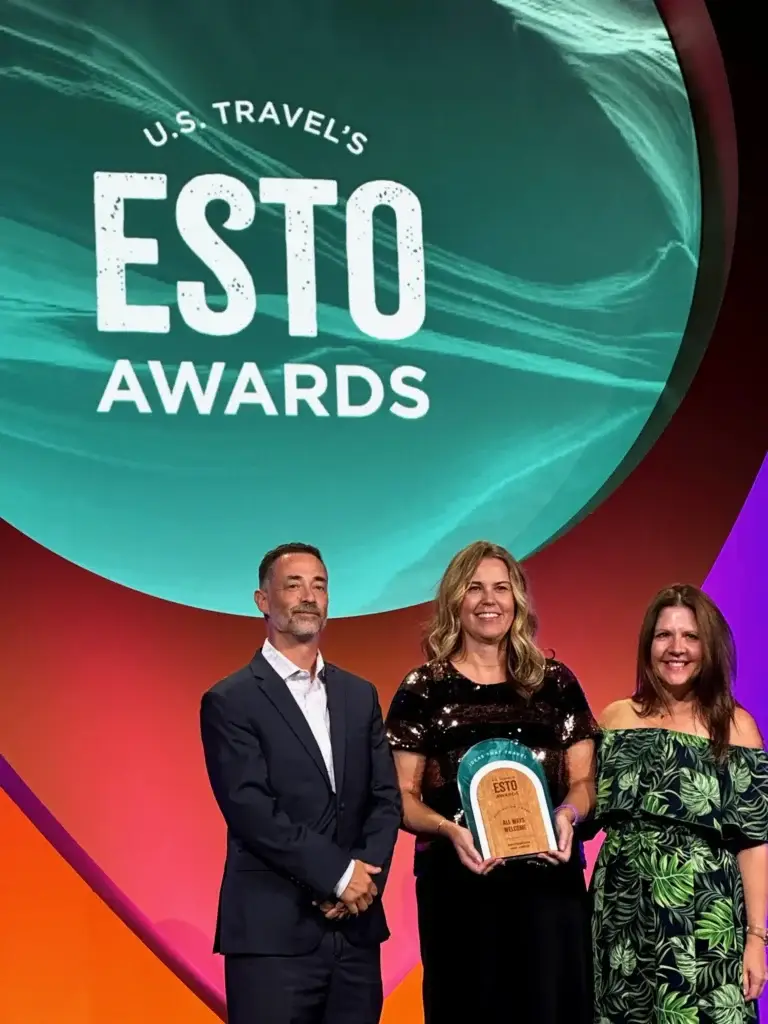
Listen to this Article
In August 2025, Destination Ann Arbor was honored with the “All Ways Welcome” Award at the U.S. Travel Association’s ESTO Conference, one of the most prestigious accolades in the American tourism industry. But what stood out wasn’t a flashy campaign or a perfectly polished slogan. Instead, Ann Arbor was recognized for something more impactful: a comprehensive, cross-functional accessibility strategy that is changing how destinations think about inclusive travel.
The award honored their work in creating welcoming, equitable travel experiences for people with disabilities and making it a foundational part of their visitor experience strategy. That distinction is exactly what makes the Ann Arbor model so compelling.
The journey began with a 2024 Pure Michigan Accessibility Grant, a seed that could have easily grown into just a handful of upgraded amenities and some brochures. But Destination Ann Arbor took a different path. Supported across departments, the team used the grant to build a destination-wide accessibility framework, integrating physical assessments, online tools, community partnerships, content strategy, and staff training into a unified whole. This initiative reflects the organization’s commitment to accessibility as a core value.
Over 50 local hotels, museums, restaurants, and venues participated in detailed assessments, each gathering more than 200 data points through a partnership with Wheel the World, a global platform specializing in accessible travel. That data now lives online, where travellers with disabilities can search, filter, and book accommodations based on precise accessibility criteria.
This initiative was never solely about ADA compliance. It was about addressing the real, everyday questions travellers with disabilities ask, such as:
- Can I get in the front door without assistance?
- Will the restroom layout actually work for my needs?
- Can I trust the information I’m seeing?
In Ann Arbor’s case, the answer is yes.
Another key reason Ann Arbor stood out at ESTO is that they didn’t stop with infrastructure. The team recognized that a truly accessible destination requires well-informed hospitality staff at every level. Through Wheel the World Academy, hotel and front-line workers were offered free training modules tailored to different types of disabilities and designed to build understanding, not just awareness. The courses cover language, etiquette, real-life scenarios, and practical service tips. This kind of training doesn’t result in scripted lines or awkward interactions. It builds confidence and confidence leads to better service for all guests.
Ann Arbor also redefined how a destination can tell accessibility stories, not by speaking on behalf of travellers with disabilities, but by letting them speak for themselves.
Social media creators like Emma Bailey, a wheelchair user with over 90,000 followers, visited the city and documented her experience. Her content didn’t spotlight polished moments or ideal scenarios. It focused on something more meaningful: the actual experience, presented without embellishment, therefore generating trust. Her audience saw what it’s like to navigate a destination where key accessibility details have been thoughtfully considered and where she didn’t have to constantly ask, adapt, or advocate. That kind of visibility goes far beyond typical destination marketing. It builds long-term credibility.
Sustaining that credibility requires more than visibility. It takes ongoing collaboration and accountability. To that end, Ann Arbor established a local accessibility roundtable made up of community advocates, subject matter experts, and residents with disabilities. This group serves as an ongoing advisory council, not a one-time panel. They meet regularly, provide feedback, identify blind spots, and help guide future decisions. And when something doesn’t work? The roundtable says so, and the team adjusts. This structure ensures that accessibility isn’t “owned” by any one team or department. It’s shared across the community.
And that spirit of shared ownership shows in the solutions themselves: not every change required major construction or massive budget lines. Many of the improvements that came out of the assessment process were simple and inexpensive, but transformational:
- Adding decals to glass doors for low-vision guests
- Publishing bed heights on hotel websites
- Offering portable shower chairs or accessible seating options
- Updating room photos to show accessibility features clearly
- Enabling ASL interpretation at events with advance notice
Sometimes, accessibility means meeting compliance standards. But more often, it means closing the gap between “technically usable” and truly welcoming.
That understanding of accessibility as an experience, not just a requirement, is what continues to drive the work forward. Destination Ann Arbor isn’t done. The team is expanding the program, adding new businesses to the assessment list, growing its library of accessibility content, and continuing to train staff and partners across the region.
The success of the program has inspired collaboration beyond city limits and sparked interest from other destinations looking to build similar systems. When asked what advice to offer those cities, the guidance is practical: Start by listening. Invite people with lived experience to the table. Don’t aim for perfection, aim for progress. And share what you learn.
Ann Arbor didn’t win the ESTO award for ticking boxes. They won it because they built accessibility into the DNA of their visitor experience strategy, and they’re still building. That work is setting a new standard for what it means to be a welcoming destination. One where everyone, regardless of ability, can explore confidently and comfortably.
And while the award may now hang on the wall, the real success is written in the guest reviews, the business partnerships, and the quiet relief of visitors who feel, perhaps for the first time, fully considered.
